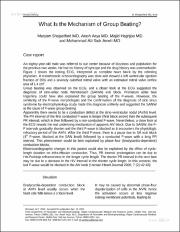WHAT IS THE MECHANISM OF GROUP BEATING?
(ندگان)پدیدآور
SHOJAEIFARD, M.ARIA, ARASH.HAGHJOU, M.SADR AMELI, M.نوع مدرک
Textزبان مدرک
Englishچکیده
An eighty-year-old male was referred to our center because of dizziness and palpitation for the previous two weeks. He had no history of syncope and the drug history was unremarkable. Figure 1 shows the resting ECG, interpreted as complete heart block by the referring physician. A transthoracic echocardiography was done and showed a left ventricular ejection fraction of 35% and a severely calcified mitral valve with an estimated mitral valve orifice area of 1.4 cm2.Group beating was observed on the ECG, and a closer look at the ECG suggested the diagnosis of sino-atrial node Wenckebach (SANW) exit block. Premature atrial beat trigeminy could have also explained the group beating of the P-waves. However, the similarity of the P-wave morphologies and the confirmation of the diagnosis of sick sinus syndrome by electrophysiology study made this diagnosis unlikely and suggested the SANW as the cause of P-wave group beating.Apparently there seems to be a conduction defect at the atrio-ventricular nodal (AVN) level. The PR interval of the first conducted P-wave is longer (first black arrow) than the subsequent PR interval, which is then followed by a non-conducted P-wave. Nevertheless, a close look at the ECG reveals the real underlying mechanism of apparent AV block. Due to SANW, the PP intervals gradually shorten and the third P-wave is blocked as it encounters the physiologic refractory period of the AVN. After the third P-wave, there is a pause due to SA exit block (4th P-wave, blocked at the SAN level) followed by a conducted P-wave with a long PR interval. This phenomenon could be best explained by phase-four (bradycardia-dependent) conduction blocks.Electrocardiographic changes in this patient could also be explained by the effect of cyclelength duration on infra-Hissian conduction. Thus, PR interval prolongation can be due to His-Purkinje refractoriness in the longer cycle length. The shorter PR interval in the next beat may be due to a decrease in the HV interval in the shorter cycle length. In this scenario, the last P-wave would be blocked in the AV node.
شماره نشریه
2تاریخ نشر
2006-03-011384-12-10





